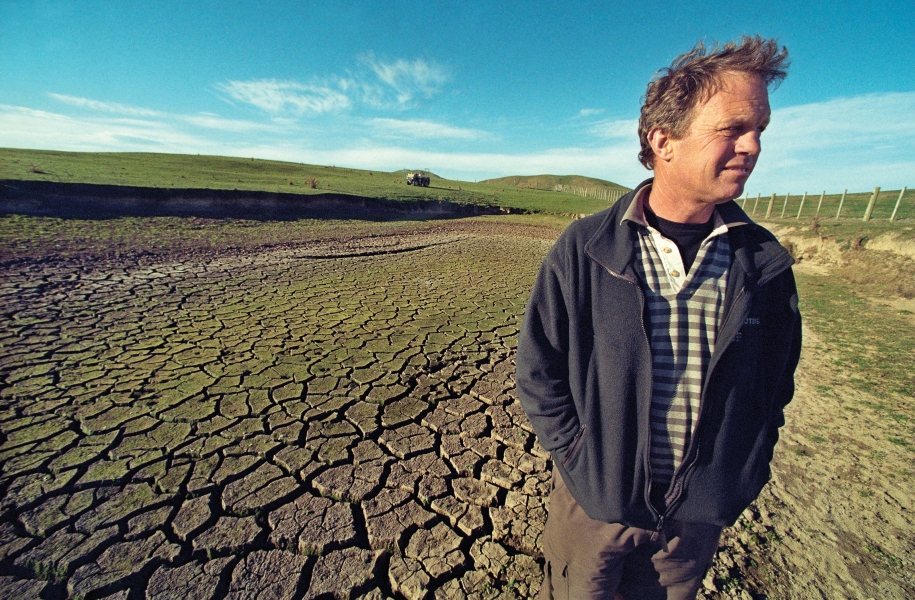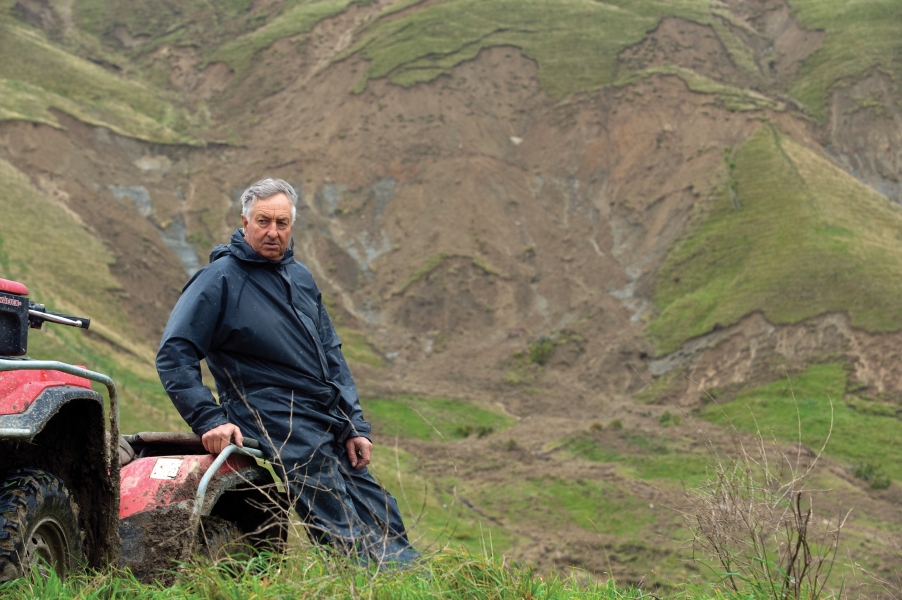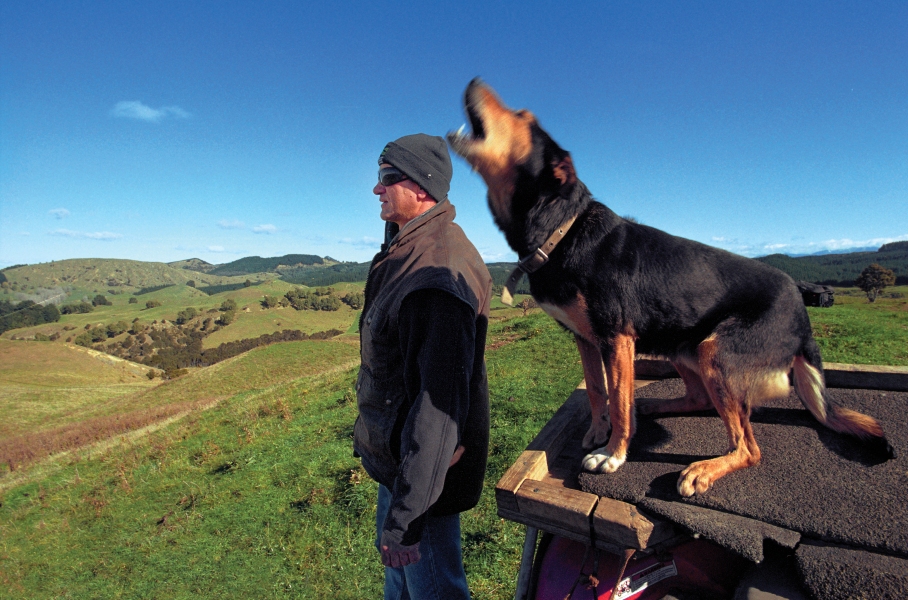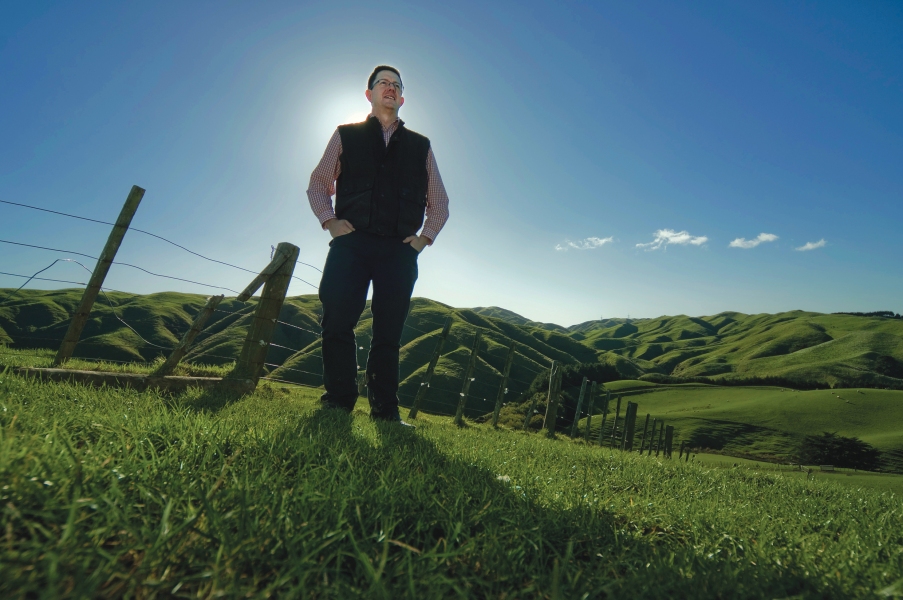Out in all weathers, farmers are the first to notice a change. By Dave Hansford.
When the creek waters reached the house, John Nation decided to get out while he still could. He and his wife Sue waded out to the Pajero, threw in some warm clothes, and pushed a bow wave down the drive, headlights helpless in the teeming dark.
At first light, they returned to a homestead they barely recognised. The grounds, the garage, the driveway, the tennis court lay buried beneath a metre of mud, the high mesh fences hurled into what was left of the garden. Rank, rotting vegetation hung from everything.
But the biggest shock came when the clouds parted to reveal the hill country of Punawaitai, the couple's 540-hectare sheep and beef farm at Pourerere.
Half of it was gone.
Nations have farmed Punawaitai, 30km east of Waipawa, for three generations. John grew up here, but he can't recall any like of that deluge. A neighbour's rain gauge recorded that this particular bit of central Hawke's Bay coast got three times the April average in 72 hours. The inundation carried away 50 per cent of his pasture: "We lost 90 per cent of a single 30-acre (12 hectare) paddock".
He coaxes the quad, clawing for grip, to the crest of a low knoll. From there, we can look straight into the face of ruination – Punawaitai is gaunt, gashed down to its papa mudstone bones. "It's tearful," says Nation. "It's emotional. The world's going haywire".
Early that Anzac Monday, these Hawke's Bay hills snagged a southeasterly low. Ponderous, bloated with rain, it couldn't rise above them. Along a narrow coastal strip between Blackhead and Cape Kidnappers, it dumped what one farmer likened to "an atomic bomb".
When it finally stopped raining on Thursday, Landcorp's Te Apiti Station was cut off, Mangakuri Station had lost 400 lambs, washed out to sea. Another 60 farmers were left staring, like John Nation, at roads and dams swept away, fences down, fodder crops buried under tonnes of silt that used to be their hill pasture. They could contain cattle – so long as they had enough feed left to tempt them to stay put. But sheep happily cross slip faces and wander, over flattened fences, onto neighbours' properties. Most will end up at the saleyards.
Blow after blow
The singular cruelty of this flood is that, for the first time in four years, Hawke's Bay hill farmers actually had good pasture cover going into autumn. Nation's rising two-yearolds were in superb shape, but he was forced to sell most of them off. Like many, he was only just beginning to re-stock after three years of drought – 2007 through 2009 – that cost the region more than $700m, and pushed a lot of farmers to the end of their overdrafts.
"That three-year drought was awful," he tells me. "That's where our finances started going to (pot). We sold most of our ewes – the prices were terrible".
"I'd still rather have a drought than this," says Sue. "You can manage a drought. You get time to make decisions".
That same April, as he looked out over the brown hills of Bonaveree Farm, Doug Avery might have begged to differ. He and Wendy bought these 1100 hard hectares at Grassmere, eastern Marlborough, off his parents in 1979, and they nearly broke him.
"Farming was all I ever wanted to do," says Avery. "It was hard when the subsidies came off, but we got through that. Then it just got harder and harder".
Marlborough has never been a particularly pluvial place, but around 1996, says Avery, "we plunged into basically continuous drought for the next eight years". Records from the nearby Dominion saltworks confirmed that, in fact, 17 of the 19 years between 1986 and 2005 were below the region's average mean rainfall.
"I wanted to give up and go somewhere else, but my roots here were too deep".
Withering heights
Such extremes – and the way we respond to them – consume Anthony Clark's thoughts. The NIWA climate scientist grew up on a bone-dry sheep farm in western New South Wales, where occasional clouds meted out just 250 meagre millimetres of rain a year. He spent a decade working on Australia's national drought policy, during which time he "started getting into the questions around links between drought and climate change".
Nowadays, nowhere is drought-proof, he says, and farmers suffer its sting more painfully because of the way we've ramped up our demands from the land. Farming today is a gamble with stakes many can barely afford; most spreads carry more animals now than ever, kept fed only by dint of heavy applications of nitrogen fertiliser. Water is the trump card; and farmers spare no expense nor technology to secure it. The dairy boom has pushed farming into a corporatised model, and shareholders have high expectations.
The costs of farming – energy, fuel, feed, fertiliser – keep climbing, yet farmers still have little control over returns.
"New Zealand's moved towards much more intensive systems," says Clark. "There are question marks around that – from a climate point of view, from a financial point of view, and from an environmental point of view".
In the fifties, he says, droughts "didn't affect agriculture as much as they do now. People got through them relatively easily, whereas the same event in the 2000s is very hard, because of that price/cost squeeze".
The 2007–09 drought changed the face of the Hawke's Bay hills. Farmers had to let stock go at fire sale prices, then had little capital left to replace them when the rain finally came.
Federated Farmers President Bruce Wills once ran 10,000 stock units on his property just off the Napier – Taupo Highway. Now, the place looks almost deserted. "Our numbers are down by 25 per cent," he tells me. "I could borrow to buy more, but four dry years in a row... you lose your nerve. We'll never run the sheep we used to – we'll never run the pasture down that close again".
Wills says it'll take him five years to repay his debts from the dry, but he counts himself lucky. The drought hiked sheep and beef farmers' average debt levels up to 46 per cent, cut incomes to an average $31,000. Federated Farmers estimated it will cost Hawke's Bay and Wairarapa farmers $190m to re-stock their farms, assuming they could feed those animals.
Adapting is what farmers do best – but climate change will be their sternest test. They might recover from one bad season, but how many hits can they take in a row? By the end of 2009, mortgagee sales were posted in the windows of Gisborne real estate agents. "Managing drought," says Clark, "is a critical part of our response to climate change. Many people concentrate on getting prepared, which is good, but what often gets forgotten is how you manage recovery after drought – whether you put your foot on the gas or not.
"In my experience, that's the critical time for most farmers. You might have a resilient business, but you can really come a cropper if you manage recovery poorly, because it's based on an expectation that things will return to normal.
"And that's where the real link to climate change comes in, because 'normal' is changing".
Making sense of statistics
Getting a handle on climate is trickier than it sounds. Droughts, or floods, don't happen solely because of climate change. They happen in a matrix of natural climate variations, combined with long-term climate change. From a background noise of what you and I would call weather, Clark and his colleagues must try to tease apart the influence of cyclic drivers such as the El Niño Southern Oscillation (ENSO) and the Interdecadal Pacific Oscillation (IPO) (see article in this edition 'Winds of Change').
Those things have a characteristic signature that Clark looks for in the data. Then he applies techniques to exclude their background noise, leaving a clearer image of the effects of climate change.
Dr Andrew Tait is a colleague of Clark's at NIWA. He goes through reams of climate data, gleaning the sort of information people – farmers, fruit growers, winemakers – need if they're going to bank their business on the weather. "Humans are putting out many more greenhouse gases than they were," he tells me. "Global temperatures have been rising – over the last 100 years, they've risen by about a degree. You can see that in New Zealand records, but also anywhere on the globe.
"So if you're introducing new farm systems ... or growing new crops, or converting to dairy – any long-term strategy – then understanding climate change projections over the next 20 to 50 years becomes really useful".
Says Tait, "We're talking about a degree warmer over most of New Zealand than it was during the latter part of the 20th century". The country may get the same amount of rain it always did, but it won't necessarily fall in the same proportions, over the same places. "In eastern areas, we're talking about five per cent drier, and in the west, maybe five per cent wetter".
Warm air holds more moisture than cold, which means that while rain may fall less frequently, it'll come in bigger dumps, as it did on John Nation's place. "You might get three dry months," says Tait, "then get those three months' worth in a single event".
If you want to know what your local climate is capable of, he says, look to the past. "Some places have 100 years of rainfall data. If you look through historical information, you can know what to expect for any time of year; air and soil temperatures, rainfall, evapotranspiration – all those things can help you understand how your pastures might grow, or how your animals might perform".
In particular, he says, watch for the anomalies. "You can see those years where things were a little different from normal, and that's particularly useful. You can put a risk assessment in place". For instance, a farmer could parse out the lowest ten per cent of low-rainfall years. From that, he might discern that he should be factoring in a drought every 10 years.
"In that sense," says Tait, "you can plan for the average, but you need a contingency in place to deal with extremes. Think about the possibilities; 'What if we got droughts three years in a row? Could we still farm through that using the systems we have in place now?'"
Clark says that when venerable agricultural production strategies struggle to cope, or fail altogether, they're flashing a warning that something has changed. "We've seen that in Hawke's Bay, where systems are not performing as they'd expect; that's a pretty good sign".
As if Doug Avery needed telling. Day after bright cloudless day didn't just burn out pasture: "We plunged, skill-less, into a total collapse of environmental, financial, and social sustainability," recalls Avery. "This whole area fell to bits. Nobody had the skills to deal with the situation. It was a horrible time; I went from a guy who loved farming to just wishing that someone would release me from my warrant".
Avery tried everything to wrest some sort of living from Bonaveree. Nothing seemed to work. He watched his topsoil, his natural capital, turn to dust and blow away. He called for help, from soil scientists, agronomists, farm management consultants, anyone he could think of. At NIWA, Alan Porteous answered the phone. "When Alan first entered the scene," recalls Avery, "I thought; 'What can he do? He can't make it rain'. But what he did was to help me understand the climatic variability that had to be part of our thinking every day. If you're prepared, and you have the tools, you can cope".
Porteous climate-modelled Bonaveree back to 1890. "When I started farming," says Avery, "we thought we were farming through a very dry period, but Alan's work showed us that we'd begun farming in the wettest decade since 1890. What we took as normal, wasn't normal".
So what will a warming climate mean for New Zealand farmers? For the economy? Milk production, in particular, is critically sensitive to fluctuations in soil moisture, rainfall and growing degree days. A single La Niña season, 1998–99, slashed milkfat production by 10 per cent. More recently, the 2007–08 drought alone cost the country $2.8b in lost productivity.
Moving the fenceposts
"Drier and warmer," says Tait, "is likely to make it more difficult to maintain current productivity, unless you've got access to irrigation. It's fair to say that's the situation farmers already face along the east coast of the North Island, where more years than not tend to be drier than the historic average. So they're moving to different systems – adapting to that new climate.
"In some cases, that might simply be changes around the edges, but in others, small changes won't cut the mustard, and it'll need a different farming strategy altogether; such as converting from dairy back to sheep and beef, or retiring hill country into trees".
Clark's calculated what he calls "a range of potential climate futures," including the likelihood of drought for different regions, "and we've been able to quantify which ones we think are more likely". The good news, especially for Southland and West Coast farmers, is that not everybody loses; pasture modelling shows vast tracts of increased productivity under climate change as the number of growing days extends into autumn in the cooler, wetter southern regions.
But the most likely, middle-of-the-road scenario, he says, amounts to "just below a doubling in drought probability in some key agricultural areas – mostly the Hawke's Bay, Canterbury and Northland. The most severe scenarios start to bite down in 2030".
Farmers will have to adapt, but Clark says much of it will be manageable. "This isn't about changing the face of agriculture". Nevertheless, farmers will have to take a long hard look at the intensity of their operations: "One response might be to farm more sympathetically with the land, or to adopt less financially-risky systems".
"It's absolutely about farming within limits," agrees Doug Avery. "We went through a crazy period where people hurled whatever they had at the land, and just expected it to perform.
"We've got a problem with the climate, and while people keep debating what's causing it, we should put all that aside and simply accept that there is change, and that CO2 levels in the atmosphere are higher. If it all came from the ground, then that's where it has to go back. The more carbon we can get into the soil, the higher the water-holding capacity of our land".
Salvation for Avery came in the form of Medicago sativa. Half the world calls it alfalfa; we call it lucerne. It grows little more than a metre high, but can put roots down to 15m, seeking out every last drop of soil moisture. A tough crown at the top of the roots can be grazed and re-grazed.
"Lucerne grows animals very quickly," enthuses Avery, "and it's pretty reliable in the spring, so we get a short window to grow lambs to a killing weight, before the summer dries us off". He can now kill his lambs at a time of year when others can't, which means he gets good prices, and has to run very few stock through the summer. Avery has turned his greatest liability – those dry soils – into a water bank. "We shut the spring moisture in, and carry it through to autumn. That takes care of our biggest environmental challenge.
"Instead of people getting all despairing, and creating fear," he tells me, "it's about solution thinking. Science came out of the university on to the farm and mucked in ... re-empowered our ability to manage this land. With that collaborative approach, we can move heaven and earth".
"Doug sifted all the information," says Alan Porteous, "and came up with a solution which certainly works for him. It's given him a new lease of life".
Porteous says producing the information is often the easy part: "but it needs to be teased out, in terms of options for the farmer. To make best use of that information, we need to be much more engaged with farmers on a regular basis".
"NIWA's done a lot of work to reduce the uncertainties about local impacts," says Clark, "and we'll keep doing that – it's really important to keep monitoring and updating. The National Climate Network's a major asset in that regard – there's a whole plethora of things farmers can access from NIWA to improve their risk awareness of climate variability.
"A lot of farmers look at the climate projections for 2030, and they're not interested; that's a long way away. They don't want to think about it, and you can understand that. But farming systems don't just miraculously pop up; they're usually long-term collaborations between farmers and researchers. We now have the technologies to start planning and re-designing farming systems".
Over most of the country, farmers will adapt to Clark's middle-of-the-road drought projections by adjusting their stocking rates and better managing their water storage. There's really a lot of adaptive potential in New Zealand farming". Then he adds, "up to a point".
Some farmers are already near that point, sailing very close to the winds of economic and environmental sustainability, where just a small degree of change could tip both balance sheets. "In some dairy systems, where we have high levels of debt, we're at those limits now. There's not much more room to move".
Canterbury – in the red
In NIWA's work, one place in particular keeps showing up in red. "We've consistently found the Canterbury plain to be the most exposed region to drought under climate change. And that's using indicators that don't factor in irrigation, so it's a pretty serious signal that we need to be on top of irrigation resource management".
Doug Avery recalls his first few years of system change as the hardest of all. "Initially, we had to slip further down the economic slide, and there was frustration and despair when some things failed. But I knew our business was doomed if we didn't change. We had to battle on.
"Until you've been severely mauled, you probably won't accept a need for change. It's all just the weather's fault. Most people just see whether they can pump the river dry – they try and box on with the same system, and enter a whole new level of debt. It's a treadmill".
Clark says any farmer on that path inevitably has to ask: "Is what I'm doing actually viable?"
His father made his own heart-rending decision to leave the land at Bathurst after the 1982 drought. "He made a business decision, in the end. It's hard, because you have that bond with the land.
"I've seen a lot of forced adjustments in Australia, and they're ugly, but they're going to happen, so ideally, you want them to be planned".
Back at Punawaitai, John Nation runs weary eyes across his ransacked hills. Unlike many of his neighbours, he won't plant pines on them. The papa slip scars will stay that way, but the easier country, he says, "will re-grass naturally. If we get a decent spring, the native clovers will come back. These slips won't look nearly as bad".
Nevertheless, Nation knows things will never be quite the same here: "The modern way hasn't worked. We tried it for years. It works for a while, but... somehow, we've gotten out of whack. It's dollar-driven; our costs have gone up so much, and they keep going up. We can't control that, and we can't control the price we get for our product, either. So we're getting squeezed".
There are two horses on the way; one for him, one for Sue. No more outlay on farm roads that could just be swept away again. They're going to farm Punawaitai the way John's grandfather did. "From now on, it'll be about what we can fence". Five paddocks instead of 65. Grow what they call, with a grin, free-range beef. A hydroponic barley feed sideline will, hopefully, keep the cashflow ticking over.
"You just hang in there and hope next year's going to be better". He laughs at his own realisation: "I've been doing that for 40 years".
-----
Customised climate data mapping
If you have a question about the climate in your neck of the woods, NIWA can answer it with data tailored to your locality, gathered from the National Climate Database. NIWA can map any aspect – or combination – of climate, including rainfall, wind speed, growing degree days, evapotranspiration, sunshine hours and frost count.
Or we can combine climate parameters with soil maps and crop requirements to produce crop suitability maps for your area.
If you want to better understand the variability of your local climate, NIWA can also map the standard deviation, or the range, or the one-year-in-ten highs and lows or the number of days in excess of any threshold you specify.
Using our High Intensity Rainfall Design System, or HIRDS (see page 5, this issue), we can map return periods and/or 24-hour rainfall totals to help assess the probability of floods and design protection works.
Seasonal climate outlooks
NIWA's seasonal outlooks give air temperature, rainfall, soil moisture, and river flow predictions for the coming three months. They state the probability for above average conditions, near average conditions, and below average conditions for those aspects.
See our Seasonal Climate Outlook for links that provide background information on how to interpret climate outlooks, and historical rainfall and temperature data ranges, for several locations within each climate outlook region.
NIWA also publishes climate summaries which review conditions and data over the past month, season, and year.
See to our Climate Summaries for more information.
Consultancy services
NIWA climate scientists can provide advice and analysis on a range of climate-related issues, ranging from statistics of various climate parameters to detailed analysis and reporting of risk, vulnerability, and adaptation options.






